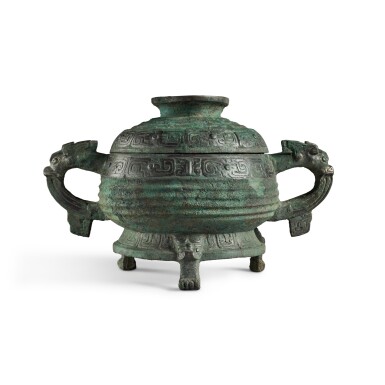Important Chinese Art
Important Chinese Art

A rare inscribed archaic bronze ritual food vessel and cover (Gui), Late Western Zhou dynasty | 西周末 □慶父簋
Auction Closed
March 23, 06:46 PM GMT
Estimate
150,000 - 250,000 USD
Lot Details
Description
A rare inscribed archaic bronze ritual food vessel and cover (Gui)
Late Western Zhou dynasty
西周末 □慶父簋
cast to the interior of the vessel and the underside of the cover with a twenty-one-character inscription reading X Qing Fu zuo qi zhong X zhan qi yinggui qi wannian meishou wujiang yongbaoyong, Japanese wood box (4)
銘文:
□ 慶父作其仲□詹其媵簋 其萬年眉壽無疆永寶用
Width 15⅛ in., 38.5 cm
Japanese Collection, acquired before the 1960s.
Masaki Art Museum, Osaka.
Sotheby's New York, 11th September 2012, lot 103.
日本收藏,得於1960年代之前
正木美術館,大阪
紐約蘇富比2012年9月11日,編號103
Wu Zhenfeng, Shangzhou qingtongqi mingwen ji tuxiang jichengsanbian [Third sequel to the compendium of inscriptions and images of bronzes from the Shang and Zhou dynasties], vol. 1, Shanghai, 2020, no. 0480.
吳鎮烽,《商周青銅器銘文暨圖像集成三編》,卷1,上海,2020年,編號0480
Identified by the character, ying 媵, in the inscription, this gui belongs to a small group of archaic bronze vessels referred as ‘yingqi (dowry vessels) 媵器’, which has significant historical value in providing insights into the ancient matrimonial traditions of the Zhou dynasty. The inscription can be translated to ‘X Qing Fu made this dowry gui for the Zhong X Zhan. May she live a long life of ten thousand years. To be forever treasured’. Zhong X Zhan was the daughter of X Qing Fu. The first character zhong 仲 in her name indicates her seniority in the family as the second oldest daughter. The second character could be her xing (family name) 姓 of the clan she came from.
In the Zhou dynasty, bronze yingqi were wedding dowries reserved for the female elite in aristocratic and royal families. These vessels would accompany a bride to her new family to be used as ritual or functional vessels. According to Gao Bing’s study, there are only around 50 extant bronze yingqi from the Western Zhou dynasty. In addition to the ones commissioned by the father of the brides, other members of the family could bestow these vessels as marriage blessings, including the mother, the husband, and the uncle. For a more detailed discussion, see Gao Bing, ‘Cong jinwen kan xizhou de yinghun zhidu / The Matrimonial System of Accompanying Concubinage in Western Zhou Dynasty Observed in the Inscriptions of Bronze Wares’, Hainan shifan xueyuan xuebao / Journal of Hainan Normal University, vol. 19, no. 5, Hainan, 2006, pp 121-124.
A group of three gui, each of closely related form and design, made by Lu Bo Da Fu for the marriage of his first, second, and third daughters, are preserved separately in the Jinan Museum, Jinan, the National Palace Museum, Taipei, and the Palace Museum, Beijing. The inscriptions of the three gui are published by Ma Chengyuan, who attributed the vessels to the late Western Zhou period, Shang Zhou qingtongqi mingwenxuan [Selection of Shang and Zhou dynasty bronze inscriptions], vol. 1, Beijing, 1988, nos 481-483.
Other well-known surviving examples of Western Zhou yingqi include the set of three E Hou gui 鄂侯簋 of a similar form, made by Marquis E for his daughter Ji who married the Zhou king. Two of the vessels are now kept in the National Palace Museum, Taipei, and the inscriptions of all three vessels are published in The Institute of Archaeology, Chinese Academy of Social Sciences, ed., Yinzhou jinwen jicheng [Compendium of Yin and Zhou bronze inscriptions], Beijing, 2007, nos 3928-3930. In addition, the Chen Hou gui, excavated in Xi’an, Shaanxi province, now in the Lintong Museum, Xi’an, made by Marquis Chen for his daughter, who was also a queen of the Zhou empire, is published in Li Boqian, ed., Zhongguo chutu qingtongqi quanji / The Complete Collection of Bronzes Unearthed in China, Shaanxi III, Beijing, 2018, pl. 543; and the Sun Hou pan, discovered from a Western Zhou horde in Xi’an, now in the Shaanxi History Museum, Xi’an, made by Marquis Sun for his third daughter, is illustrated in Zhang Tianen, ed., Shaanxi jinwen jicheng [Compendium of bronze inscriptions in Shaanxi], vol. 11, Xi'an, 2016, no. 1212.
Gui were used during ritual ceremonies for storing cooked rice or millet. While this vessel shape first appeared in the Erligang phase, they were not widely produced and examples from this period are rare. This form increased in popularity from the early Western Zhou dynasty, and numerous variations of the original shape also began to appear. The present vessel, with its shape and design, represents a popular form during the late Western Zhou period.
Compare a set of bronze gui of a very similar form and design from one of the most important vassal states of the Western Zhou dynasty, the Guo state, excavated in the tomb of Guo Ji in Sanmenxia, Henan province, illustrated in Institute of Archaeology of Henan Province, Archaeological Team of Sanmenxia, Sanmenxia guoguo mu / The Guo State Tombs in Sanmenxia, vol. 1 (II), Beijing, 1999, pl. V; an uninscribed example, excavated from a Western Zhou tomb in Quwo county, Shanxi province, published in Wang Shimin et al., Xizhou qingtongqi fenqi duandai yanjiu / A Study of the Periodization and Dating of Western Zhou Bronzes, Beijing, 1999, p. 92, fig. 79 (line drawing); and a famous Song gui with slightly more elaborate handles and feet, in the Shandong Museum, Jinan, illustrated in Peng Qingyun, ed., Zhongguo wenwu jinghua daquan: Qingtong juan [Encyclopaedia of masterpieces of Chinese cultural relics: Bronze volume], Taipei, 1994, p. 115, no. 0401.
